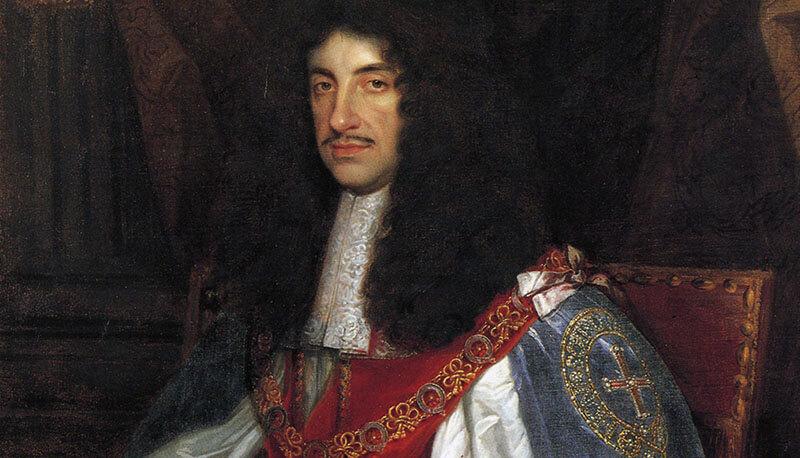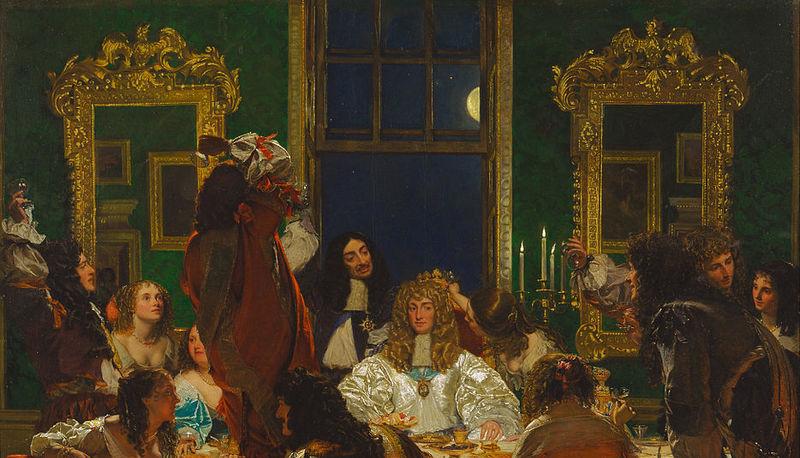Concetti Chiave
- The Restoration (1660-1702) period marked the return of the monarchy with Charles II, bringing French influence and ending the Puritan lifestyle, characterized by elegance, licentiousness, and libertinism.
- John Dryden, a prominent figure of the era, reflected the political, religious, and artistic life of his time through a variety of genres, helping to shape neoclassical literature with his informal, yet precise prose.
- William Congreve's Restoration Comedy, notably "The Way of the World," exemplifies the witty, elegant plays of the period, focusing on themes like marriage and social reputation with complex plots and symbolic characters.
- Restoration drama introduced innovations like movable painted scenery and artificial lighting, with women performing female roles, catering to an audience of noblemen and the upper and middle classes who sought entertainment and social interaction.
- Influenced by Molière, Calderon de la Barca, and Commedia dell’arte, Restoration comedy highlighted the superficiality and moral laxity of the upper classes, focusing on love, marriage, and societal conflicts.
Indice
The Restoration (1660-1702)
It means the restoration of the monarchy: Charles II returned from exile and began to reign because he was the legitimate heir to Charles I. The Restoration was initially welcomed by the British people. The Restoration, a period of 40 years, has a French influence: vice and dissipation. Charles II is nicknamed “the merry monarch” for reopening of theatres and because he introduced old and new form of entertainment (bull baiting, bear beating, masque, dances, operas, music). As a consequence of French influence there is the end of Puritans lifestyle: elegance, affectation, licentiousness, immorality, corruption, cynicism, libertinism, love of pleasure. Charles’ home policy: The first concern of the king was to reassert the predominance of the established Church of England, and to bring it once more under direct control of the Crown. English foreign policy was not successful. In the Dutch War of 1664 Britain was defeated and had to revoke an advantageous maritime agreement with Holland. Four years later she made a Triple Alliance with Sweden and Holland against France. Charles II had to announce his conversion to Catholicism; in chase of opposition French army would have defend Charles. In 1679 Parliament promulgated the Exclusion Bill to exclude James, Charles’ Catholic brother, and proposed Mary (James’ Protestant daughter) and William of Orange. The king dissolved the Parliament, the law was reproposed: James dissolved the Parliament again and never called it for the last four years of his reign. In this period the Parliament is divided into: Whigs: middle class that wanted as king Mary and William of Orange; Tories: aristocracy that wanted as king James II. 1665- Great Plague and there was also the Great Fire of London. Literature was encouraged: there was a more rational way of looking at life and so of writing. So there was also a new prose style; simpler and more concise. James II, a Catholic, was more absolutist than his brother Charles II, in fact he tried to reintroduce Catholicism and so he caused rebellions. Meanwhile his wife had a catholic son: this fact accelerated the secret plan of Parliament to call William and Mary of Orange. In 1688 William landed in Great Britain. The next year William and Mary are crowned king and queen of England: this period is called the Bloodless (Glorious) Revolution. In 1694 Mary died and William had to reign alone. Act of Settlement: catholic are excluded from the throne. Bill of Rights: established that the crown would not be able to rule the country without parliament.
Charles’ home policy: The first concern of the king was to reassert the predominance of the established Church of England, and to bring it once more under direct control of the Crown. English foreign policy was not successful. In the Dutch War of 1664 Britain was defeated and had to revoke an advantageous maritime agreement with Holland. Four years later she made a Triple Alliance with Sweden and Holland against France. Charles II had to announce his conversion to Catholicism; in chase of opposition French army would have defend Charles. In 1679 Parliament promulgated the Exclusion Bill to exclude James, Charles’ Catholic brother, and proposed Mary (James’ Protestant daughter) and William of Orange. The king dissolved the Parliament, the law was reproposed: James dissolved the Parliament again and never called it for the last four years of his reign. In this period the Parliament is divided into: Whigs: middle class that wanted as king Mary and William of Orange; Tories: aristocracy that wanted as king James II. 1665- Great Plague and there was also the Great Fire of London. Literature was encouraged: there was a more rational way of looking at life and so of writing. So there was also a new prose style; simpler and more concise. James II, a Catholic, was more absolutist than his brother Charles II, in fact he tried to reintroduce Catholicism and so he caused rebellions. Meanwhile his wife had a catholic son: this fact accelerated the secret plan of Parliament to call William and Mary of Orange. In 1688 William landed in Great Britain. The next year William and Mary are crowned king and queen of England: this period is called the Bloodless (Glorious) Revolution. In 1694 Mary died and William had to reign alone. Act of Settlement: catholic are excluded from the throne. Bill of Rights: established that the crown would not be able to rule the country without parliament.Toleration Act: freedom of religion.
John Dryden (1631-1700)
Despite his popularity during the Restoration and even today, little is known about John Dryden except what is contained in his works. In 1682, he declared himself an Anglican. When James took the throne in 1685, however, Dryden converted to Catholicism. Every important aspect of the life of his time (political, religious, philosophical, artistic) finds expression somewhere in his writings. He wrote celebration and satirical poem, essays, quatrains, odes, plays and a poem which is an ode to music for the musical society annual celebration, A Song for St. Cecilia’s Day. There’s the comparison between the heavenly music that created the universe and human music, powerful enough to inspire human passion and feelings. The first one is the bigger (it’s given earthly manifestation trough the organ, invented by St.Cecilia.Dryden’s critical writings established canons of taste and theoretical principles that determined the character of neoclassic literature in the next century. He helped establish a new sort of prose (easy, lucid, plain, and shaped to the cadences of natural speech). This is the prose that we like to think of as “modern”. He was informal and apparently artless. His metric was vigorous and various, his language was dignified, unaffected, precise and always musical (it was a noble instrument of public speech).

William Congreve (1670-1729) is the major playwright of Restoration Comedy. Born in 1670, he was educated in Ireland. In 1691 he went to London to study law but he soon became a wit. He began to write for theatre: The Old Bachelor, Love For Love. The greatest Congreve’s comedy was written at the end of the Restoration: The way of world (1700) Millamant is surrounded by lovers, but she likes Mirabell best. He is the perfect rake. He likes her too, but their union is opposed by Lady Wishfort, Millamant’s aunt who is infatuates with Millamant rake. The two lovers manage to marry. The plot is built on incidents and typical characters of Restoration comedy: two young and witty lovers, the pompous fool, the country squire, misunderstandings and role exchanging; adultery, conflict between sensuality and respectability. The central theme is the difficulty if arranging the marriage of the two lovers.
The comedy is witty and elegant.
Restoration drama is divided into three parts
Tragedy: heroic play and comedy of manners. Theatres had been closed from 1642 to 1660 (Puritan period). Christopher Wren was asked to build two new theatres for the two companies officially recognised by the king, Charles II.Characteristics of the theatre:
- Movable painted scenery
- Use of artificial lightning (candles)
- Women play female role
- Actor are professionals (contract)
Restoration comedy:
- the best expression of the superficiality of the age;
- it is written by and for the court wits, so it reflects their vision of life;
- it is a description of contemporary court society;
- it shows the lack of ideals and the dissoluteness of the higher classes;
- it is written in prose;
- it wants only to amuse and to entertain;
Commedia dell’arte (farcical elements);Comedy of humors (Ben Jonson).
The characters: they have symbolic names which correspond to a precise social type:
- the jealous husband;
- the fop: elegant, witty and cynical;
- the lady of fashion. Plots: complex with numerous subplots.
Themes:
- love: war of wits; men and women try to cheat each other. Attraction, vanity, social reputation, not passion;
- marriage: the means of setting rich or richer;
- conflict town/country: city rakes try to seduce country girls/wives. Country people are considered low and ridiculous
- pursuit of sex and money.
Domande da interrogazione
- ¿Qué significó la Restauración para Inglaterra?
- ¿Cuál fue el papel de John Dryden durante la Restauración?
- ¿Cómo se caracteriza la comedia de la Restauración?
- ¿Qué innovaciones se introdujeron en el teatro durante la Restauración?
- ¿Cuáles son los temas principales de la comedia de la Restauración?
La Restauración (1660-1702) significó el retorno de la monarquía con Carlos II, quien reabrió teatros e introdujo nuevas formas de entretenimiento, marcando el fin del estilo de vida puritano y el inicio de una era de elegancia y libertinaje.
John Dryden fue un destacado escritor de la Restauración, conocido por su poesía, ensayos y obras teatrales. Sus escritos reflejan aspectos importantes de su tiempo y ayudaron a establecer principios literarios neoclásicos.
La comedia de la Restauración es conocida por su superficialidad, escrita para los cortesanos, reflejando la sociedad contemporánea con falta de ideales y disolución de las clases altas. Se centra en el entretenimiento y la diversión.
Durante la Restauración, se introdujeron innovaciones como escenarios pintados móviles, iluminación artificial con velas, y mujeres interpretando roles femeninos. Los actores se convirtieron en profesionales con contratos.
Los temas principales incluyen el amor como una guerra de ingenios, el matrimonio como medio para mejorar económicamente, el conflicto entre la ciudad y el campo, y la búsqueda de sexo y dinero.






 Accedi a tutti gli appunti
Accedi a tutti gli appunti
 Tutor AI: studia meglio e in meno tempo
Tutor AI: studia meglio e in meno tempo